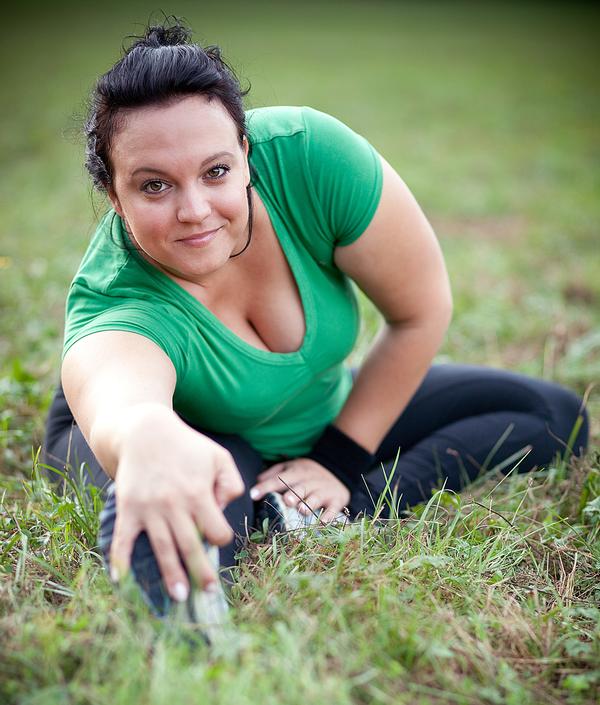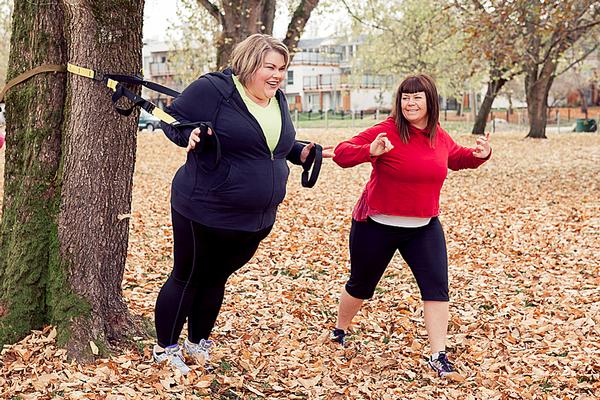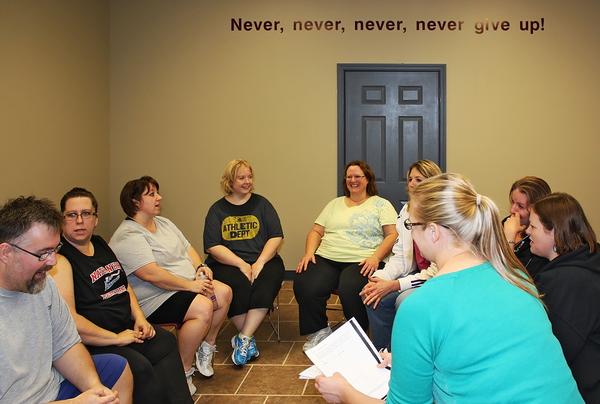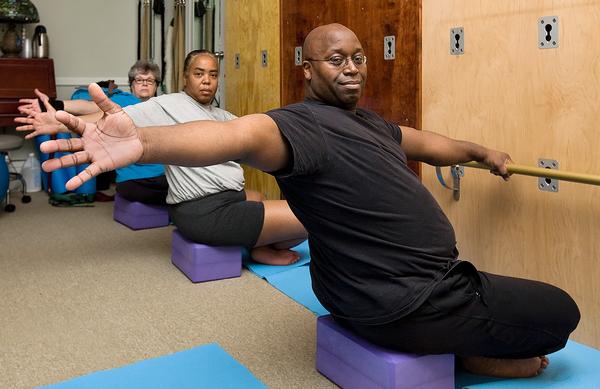 SELECTED
ISSUE
SELECTED
ISSUE
|
|
Leisure Management - A big welcome

Health & Fitness

|
|
| A big welcome
|

For some overweight people, going to a gym or exercise class is a daunting prospect. Kath Hudson talks to gym operators specifically targeting plus size customers while trying to offer a more welcoming environment
|

Operators are finding that it’s important to offer emotional support to those wanting to lose weight
|
|
|
In the US and the UK, 60 per cent of people are either overweight or obese. Obesity causes many health issues including some cancers, heart disease, diabetes and high blood pressure, stress, illness and depression. Some experts believe that obesity is responsible for more ill health than smoking. Although this is a hard market for the fitness industry to reach, we are now seeing concerted efforts to meet the needs of overweight consumers. “The opening of gyms specific to plus size people in the US is indicative of a wider change within the sector; a move towards adapting to the needs and demands of consumers and offering increasingly niche fitness facilities and programmes,” says CEO of ukactive, Dave Stalker. “A cultural shift has begun in the sector towards viewing people in a holistic way, and looking at the causes of an individual being overweight, rather than just treating the consequences. We need to continue to build on this, through further innovation and collaboration, to reach the large percentage of the population who remain inactive.” In the UK we are starting to see a change in programmes offered: LA Fitness has partnered with Weight Watchers to join up physical activity and nutrition. Fitness First has launched weight management classes, and groups such as Nordic Walking link in with local healthcare providers to deliver programmes for the management of obesity and related conditions. There is also a rise in niche qualifications in areas such as weight management, nutrition and psychology. Curves and Gymophobics target their marketing at women who want to get more active but may not have previously felt comfortable using a gym. Also, the ukactive Research Institute is currently working with fitness centres across the country to build an evidence base for delivering physical activity counselling to people who may be overweight and suffering from chronic health problems, to help them make positive lifestyle changes. Currently the successful plus size offerings are run by people who have successfully lost weight themselves and so understand the challenges and the fears that overweight people have about entering gyms and starting to exercise. To just cover fitness is not enough, so most providers look at nutrition, and give counselling support too. US operator Downsize Fitness is aimed at people who are at least 50lbs overweight and takes a holistic approach to its members’ lifestyles. Each time someone comes to the gym they work out with a trainer, who also holds them accountable for their diet. Here we take a look at a few other fitness operations designed specifically for overweight customers.
|
|

|
Louise Green
Founder
Body Exchange
I set up Body Exchange in Vancouver in 2008, as a lifestyle change, after having a baby. Previously, I was working as a talent agent in the film industry. It was stressful and involved long hours, and I thought it wouldn’t mix well with motherhood.
While pregnant I gained around 45lbs, but I was still passionate about working in fitness, so I decided to target upper size people. I did some market research and found there is nothing dedicated to this group of people in Canada. It immediately attracted a lot of media interest, so I realised that it was very timely.
No one is banned, but the language and image of our marketing material is targeted at upper size people. To market the business we have looked at the lifestyle patterns of the ideal client and gone to them, as they won’t come to us. I call places like Weight Watchers clubs watering holes, as here you find larger people, who are motivated to change. Doctors also refer people to us.
The programme is bootcamp-style, using equipment like resistance bands, bosus and agility ladders, and is run in community-based locations. Exercise takes place either one-on-one, or in classes, which vary in size from five to 25. We don’t run sessions in health clubs, because our customers wouldn’t enter the buildings; they are in community halls, or outside. Body Exchange also offers an online customisable nutrition programme, as well as goal setting and lifestyle coaching.
We offer a two day or three day a week programme. To start with, people are fearful that they won’t keep it up. People come with a lot of fear and lack of trust in themselves.
The sense of community in the group really builds motivation. Our customers organise hikes and snow shoeing in the mountains together. For those who buy into it, retention is really good.
Some people lose huge amounts of weight and transform their bodies. Others come off their medication and are now no longer pre-diabetic. Others become more fit but don’t lose weight, because they can’t control their eating. I think that we are dealing with a lot of emotional eating. Very often obesity is just a symptom of a deeper problem. Eating is the biggest struggle for most.
I have now licensed the business, so it is in six different communities in Vancouver, but I want to make Body Exchange a national company, through licensing. Alberta, Calgary and Ontario are the first cities I want to target and as I’m originally from the UK, I would also like to take it there.
| |


|

Green runs exercise sessions outdoors or in community halls |
|
|

|
Marty Wolff
Founder
Square One
I’ve lived 25 years of my life morbidly obese and learned many bad habits, but always wanted something else. When I appeared on The Biggest Loser, I found my place, as well as meeting my wife.
After leaving the show 146lbs lighter I did a lot of public speaking, which culminated in launching Square One in Omaha, US last year. It is a club of like-minded people of size. Most are morbidly obese and we use a mixture of exercise, therapy, dieting and mentoring on how to tackle obstacles to help members control their triggers and craving. Most of them have no clue about the fight they are fighting, or how to defend themselves, so we help them to build strategies.
The programme is based on a mix of my own experience and research. For example, one thing obese people tend to suffer with is an all or nothing mentality. So they think that if they break the pattern by eating a cookie, they might as well give up that day. I compare this to spending money. If you buy one thing you haven’t planned, you don’t have to go and empty the bank account. There is a big grey area and we help people to understand it.
Many people see incredible results with weight loss, but some people simply can’t get past the emotional eating and fail to lose weight. Working out is the easiest habit to grasp, because I can watch them, but I can’t watch them when they’re at the fridge at home.
Even when people are obese, or morbidly obese, exercising can make a massive difference. For example, losing 8lbs to 10lbs could mean reducing or coming off blood pressure and cholesterol medication for some.
Recruiting members is one of the things we are still learning how to do. The difficult part is working out how to approach people and we are experimenting with that, for example targeted advertising on Facebook, for those who have liked The Biggest Loser and Weight Watchers. We are also using radio and I meet a lot of people through public speaking. People hear of my struggles and can relate to them.
When compared to the industry standard, we do a really good job at retaining people. This is because we have created a community of people. We have a large private Facebook page with a community, which many people rely on as a support system.
Square One offers a number of packages, starting at $60 and rising to $300. Whether working out in the gym, or classes, PT or small group training, people always have to work under the guidance of a trainer.
Going forward, we are planning to franchise the concept, initially in the mid-West of the US.
| |


|

Topics covered in classes include goal setting, nutrition and emotional eating |
|
|

|
Michael Hayes
Founder
Buddha Body Yoga
I was tired of being the biggest person in the yoga class, so in 1996 I embarked on a Sivananda yoga teacher training course in Barbados. After this, I developed my own practice and worked privately with another teacher, discovering how to get my body into the yoga postures.
Buddha Body Yoga grew out of this experimentation and is the only yoga offering that I know of which caters exclusively for plus size people.
Although with my skills I could teach regular yoga, I find larger people more interesting and challenging to work with. Millions of teachers work with the slender, strong and fit, but only a handful work with big people.
I run seven classes a week at our New York studio and am just negotiating new space so that I can expand my class size. Finding clients is not necessarily easy; word of mouth and media coverage seem to be the best way.
However, many plus size people are scared to come to classes. I have had people register and not turn up, or arrive five minutes late but then refuse to join the class.
Once people start coming, retention is good, because I make it fun; it’s like a community with lots of jokes and playing with postures. It’s not really serious, like many other yoga classes.
Some people come because they want to lose weight, some want to be more flexible, some want to experience yoga and others like the feeling of movement. If I can stop someone hobbling, or help them move and sit more comfortably, I consider that a success. Very often large people are flexible, but they are disadvantaged by muscle tone and gravity. Some muscles are weak and others over-strengthened. My challenge is to teach the strong muscles to relax and strengthen the weak ones.
I would like to take the concept across the US and around the world by running teacher training classes. I’ve just set up a certified five day yoga teacher training programme on working with big people, which is open to qualified yoga teachers.
"Although with my skills I could teach regular yoga, I find larger people more interesting and challenging to work with. Millions of teachers work with the slender and fit, but only a handful work with big people"
| |


|
| PHOTO: Andrew Kelly Media |

Hayes adapts standard yoga poses for larger people |
|
|
 |
| Originally published in Leisure Management 2013 issue 2
|
|
 |
|